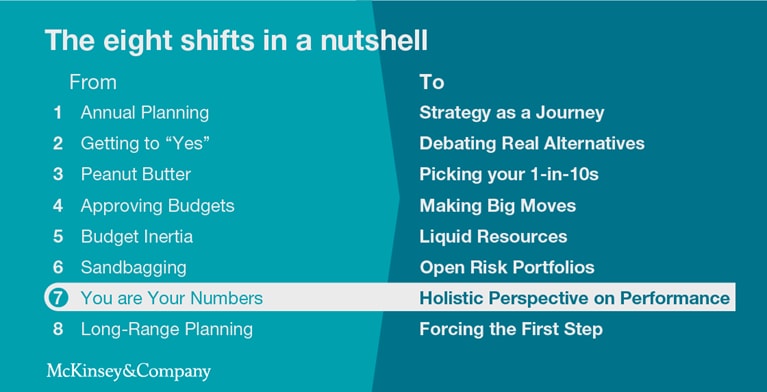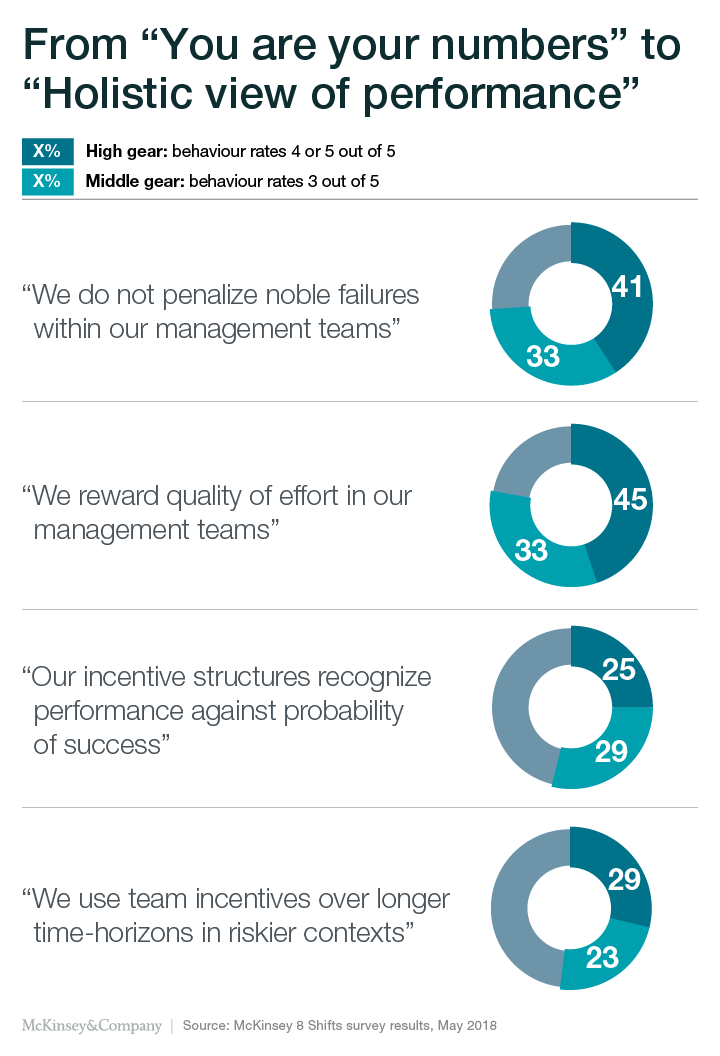When a major fire breaks out and is successfully put out, you don’t heap accolades on the one fire station that happened to be nearest to the conflagration. You look at the performance of the system as a whole—only by having stations at strategic points throughout the city can the fire department be effective.
Likewise, in corporate strategy, the urge to push for individual accountability and reward individual success can be counterproductive, because strategy is a team sport. It is overall corporate performance that matters, and that requires a sense of shared ownership in the results. Leaders who hope to overcome the social games, individual biases, and corporate politics that so often trip up strategies can’t change the game alone. Your whole team must embrace the new way.
That requires making clear that people won’t be punished simply because a high-risk plan didn’t pan out. I often see business unit leaders being pushed to accept “stretch targets” that management knows have perhaps a 50% chance of being achieved (what I would call a “P50” plan), only to have these low up-front probabilities ignored when it comes to the performance review at year-end. Executives know that they “are their numbers,” and they react accordingly to attempts to set ambitious goals: They sandbag their targets to protect their careers.
Bringing probabilities to the fore can reset these dynamics and overcome the resistance to risk, provided you extend the approach to how you evaluate and reward performance. That additional step is necessary to get business leaders’ full commitment to the big moves required to advance your company up the Power Curve of economic performance.
Here is how to go about it.

Focus on quality of effort, not result
To start, you need to understand the chances of a given initiative’s success. Are you committing to a P30, a P50, or a P95 plan? If the project fails, the analysis should then form the basis of the year-end conversation about whether you’re looking at the failure of a highly aspirational goal or one that shouldn’t have been much of a stretch.
Ed Catmull, president of animation studio Pixar, is very deliberate about allowing for noble failures. He labels some projects “experimental” (that is, not aimed at theatrical release) to encourage people to try riskier ideas. He also funds some ideas considered to be “unlikely,” so failure doesn’t become a stigma. But he acknowledges how challenging this can be: “We have to try extra hard to make it safe to fail.”
Naturally, you should delve into what drove the outcome—and, importantly, you should do that not only for failures. It’s equally important to understand the causes of successes. You don’t want to punish noble failures, but you also don’t want to reward dumb luck. The aim is to motivate true quality of effort. At Gore-Tex, for instance, teams get data on performance and vote on whether a team and its leader “did the right thing.” This vote is often closer to the truth of what happened than the data.
Reflect probabilities of success in incentive plans
I’m not suggesting you go to a “balanced scorecard,” which just opens the field for new social games. Instead, I propose an unbalanced scorecard for incentive plans. It would have two distinct halves: On the left would be a common set of rolling financials with a focus on two or three, such as growth and return on investment, that link to the economic profit goals of the division and enterprise. The other side would show a set of strategically relevant initiatives and actions that underpin the plan.
The hard numbers on the left help establish a range for incentives and rewards, and the strategic initiatives on the right can be “knockout” factors, with failure on P50 plans getting treated more softly than on P90 projects. In other words, the way you get the results matters as much as the results themselves.
Use team incentives for riskier plays
Some initiatives have short-time horizons, are easily monitored, allow only a small role for luck, and have an obvious link between action and outcome. In these cases, detailed key performance indicators (KPIs) with heavy individual incentives make sense. But for many other tasks, time lags, the need for cooperative effort, and “noisy” outcomes make analyzing performance more complex. That’s why foreign exchange traders have very strong individual incentives but school teachers don’t.
In any team game, doing the right thing doesn’t mean that every individual scores a goal. If you want good results from a corporate portfolio of strategic moves, you need to encourage enough risk-taking at the individual level so the corporate risk profile is optimized. In too many cases, individual risk aversion prevails and the riskier moves get whittled out, even if they would make the average team performance much better. That’s why, as risk goes up, individuals should be rewarded based on team performance.
Of course, you don’t want free riders, so you must find a balance. You need assurance that every member of the team is pulling their weight. But if you want your team to embrace risk, put a bigger shared component into individual incentives.
Judging by our recent survey of executives, most companies have a considerable way to go in acknowledging the probabilities of success in their incentive structures and in offering shared incentives for longer-term, riskier initiatives.

But making these shifts is worth the investment. By creating a sense of shared ownership in the company’s fortunes and a clear alignment of incentives, you can get the full commitment of your team to the big moves you need to make.
Chris Bradley is a senior partner in our Sydney office and coauthor of Strategy Beyond the Hockey Stick with Martin Hirt and Sven Smit.
This article was originally published on LinkedIn.
